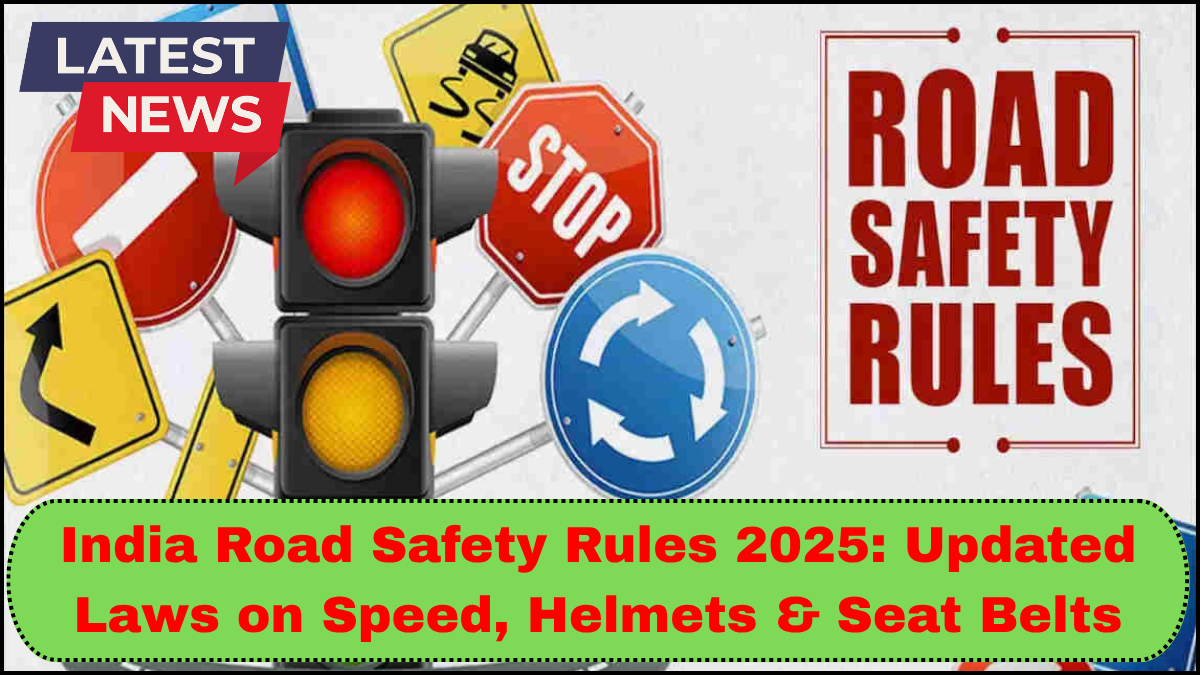India has introduced a fresh wave of reforms under the Road Safety New Rules 2025, targeting one of the most critical issues the country faces: traffic fatalities. With over 150,000 lives lost annually in road accidents, these new measures are a strong response aimed at tightening compliance and saving lives. The latest updates focus sharply on speed limits, helmets, and seat belts, alongside improved enforcement protocols and stricter penalties.
Let’s break down the most crucial changes and how they affect drivers, riders, and passengers across India.

Stricter Speed Limits: Tiered and Location-Sensitive
Under the Road Safety New Rules 2025, the Ministry of Road Transport and Highways has recalibrated speed limits based on road types and vehicle categories. This change comes in response to growing urban congestion and accident data that show overspeeding as a primary cause of road deaths.
New Speed Limit Structure:
-
Urban roads (within city limits):
-
Cars: 50 km/h
-
Two-wheelers: 40 km/h
-
Heavy vehicles: 40 km/h
-
-
National highways passing through cities:
-
Cars: 70 km/h
-
Two-wheelers: 60 km/h
-
Heavy vehicles: 60 km/h
-
-
Open highways and expressways:
-
Cars: 100–120 km/h depending on lane and signage
-
Two-wheelers: 80 km/h
-
Heavy vehicles: 80 km/h
-
These revised limits are now enforced using AI-enabled speed cameras and e-challan systems. Overspeeding violations automatically trigger fines ranging from ₹1,000 to ₹5,000, and repeat offenders risk license suspension.
Helmet Regulations Reinforced: No Compromise on Quality or Fit
In an aggressive push to protect two-wheeler riders, the Road Safety New Rules 2025 mandate the use of ISI-certified helmets for both rider and pillion. The focus is not just on wearing a helmet but wearing the right one.
What’s Changed:
-
Non-ISI helmets banned: Use or sale of uncertified helmets is now punishable with fines and seizure.
-
Helmet fit and fastening: Loose helmets or unfastened chin straps will be treated as non-compliance.
-
Mandatory for pillion riders: Whether it’s a city commute or a highway ride, both riders must comply.
The penalty for non-compliance has been increased to ₹2,000. In some states, traffic cops are authorized to seize the vehicle on repeated violations.
Example:
In Maharashtra, helmet compliance checks have been integrated into insurance renewal systems—no helmet, no policy renewal.
Seat Belts for All: Front and Rear Occupants
A major update in the 2025 laws is the mandate for seat belt usage by all occupants, not just front-seat passengers. This is a shift in mindset that acknowledges the dangers faced by rear passengers in collisions.
Key Points:
-
Rear seat belt mandatory: Passengers in the back must wear seat belts or face a ₹1,000 fine.
-
Commercial vehicles: Buses and taxis must now be equipped with functional seat belts for every seat.
-
Child safety seats: For children under 12 years or shorter than 135 cm, child restraint systems are now compulsory.
Insurance claims can now be denied in some states if it’s proven that injury occurred due to non-usage of seat belts.
Better Enforcement, Higher Penalties
The new rules aren’t just about policy—they’re about action. Enforcement in 2025 is now data-driven:
-
CCTV and AI-based surveillance on urban roads.
-
Integrated traffic violation records linked with driving license databases.
-
Immediate challan alerts via SMS and online platforms.
Even private app-based aggregators like Ola and Uber must ensure compliance. Drivers failing to enforce helmet or seat belt rules for passengers face penalties and app suspension.
Promoting Road Safety Through Awareness
In addition to legal reforms, the government has launched a national campaign: “Drive Safe India 2025”, which aims to educate drivers about the risks of negligence. Schools, corporates, and transport unions are actively participating in workshops, training sessions, and digital modules.
FAQs on Road Safety New Rules 2025
Q1. Are the new speed limits the same across all Indian states?
No. While the central guidelines exist, individual states may impose stricter limits based on local conditions. Always check local traffic department updates.
Q2. Can I still use a half-face helmet under the new rules?
Only if it is ISI-certified and securely fastened. Unapproved helmets, regardless of design, are banned.
Q3. What if my car’s rear seats don’t have seat belts?
Vehicles manufactured after 2017 must have rear seat belts. If yours doesn’t, you’re legally required to retrofit them.
Q4. How are violations tracked now?
Through a combination of AI-powered CCTV, speed detection devices, and integrated vehicle databases. Most fines are now sent digitally.
Q5. Are child safety seats really mandatory?
Yes. The new law makes it compulsory for children under 12 or below 135 cm height to be secured in a certified child restraint system.
click here to learn more